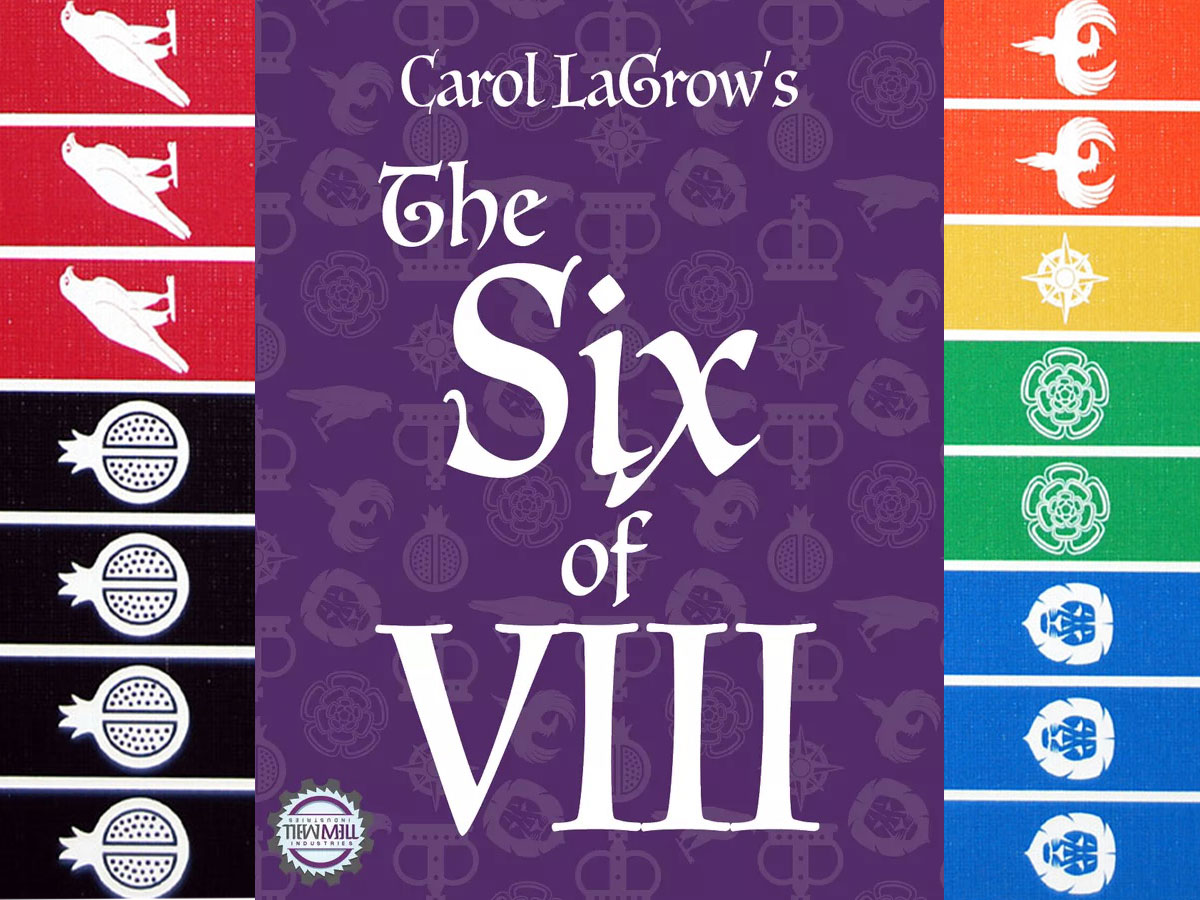King Henry VIII was famous for having a lot of wives, and even creating the Church of England so he could divorce and remarry. This clever trick-taking game follows the timeline of the six Queens.
What Is The Six of VIII?
The Six of VIII is a trick-taking game for 3 or 4 players, and takes 15–60 minutes to play (depending on whether you play the short game or the full game). There isn’t a recommended age on the box, but I would say probably 10 and up, depending on your kids’ familiarity with trick-taking as a genre, since most of the mechanics used are similar to other trick-taking games. While it does have a 3-player variant, the game is ideally suited for 4 players. The Six of VIII is currently available for pre-order from New Mill Industries for $20; the pre-order will run until the end of February, and is expected to ship in early May.
The Six of VIII was designed by Carol LaGrow and published by New Mill Industries, with graphic design by Daniel Newman.

The Six of VIII Components
Note: My review is based on a prototype copy, so it is subject to change and may not reflect final component quality, though the final quality will likely be very close to what you see here.
The game components are pretty simple:
- 63 Deck cards
- 3 Timeline cards
- Crown timeline marker
- Church of England card
- 3-Player card
New Mill Industries generally has small print runs and simple components—their games aren’t flashy but the components are a fine quality and I also appreciate the compact box size.

The cards for the deck are laid out simply and clearly: numbers at all four corners (for left- or right-handed players!), with large and small suit symbols, and a colored background—you can distinguish the queens by symbol or color. Some of the cards have small diamonds on the left and right edges for scoring purposes, and the special zero-value cards have a different colored stripe across the middle, but we’ll get to those later. The values of the cards range from 1 to 12, though there are fewer cards in some of the suits.

The timeline cards are placed end-to-end to form a 15-segment timeline with the symbols and colors going across, with each Queen having a number of segments roughly representing the length of her reign. There’s a tiny gold crown used to mark the current year, and it’s a very cute little component—about the right size for a LEGO minifig.
The whole thing comes in a simple box with a lid, the size of two card decks. My only minor complaint about the box is that it doesn’t have the little thumb cutouts, and since the game is pretty light, sometimes you have to shake the box a bit to get the lid to slide enough to open the box.
How to Play The Six of VIII
Since the game’s main rules are for four players, I’ll explain those rules first, and then the 3-player differences.
The Goal
The goal of the game is to score the most points by winning tricks. A short game is one hand; a full game is one hand per player.

Setup
Set up the timeline and place the crown on the first year (with the black pomegranate icon, representing Catherine of Aragon).
Sit across from your teammate. Shuffle the deck cards and deal 15 cards per player. For the basic rules, remove the two double-colored spy cards, the purple King of England, and the Church of England card first. Choose a random starting player.
Every player chooses 2 cards to pass to their partner face-down.

Gameplay
The game mostly follows standard trick-taking rules: the first player plays any card from their hand, and everyone else in turn order plays one card of the same suit if possible. If you do not have a card of that suit, you may play any card instead.
The timeline shows which suit is currently the trump suit, which outranks all other suits. After everyone has played one card to the trick, the player who played the highest trump card wins; if nobody played a trump card, then the highest card of the starting suit wins. The winning player takes the cards and sets them in a scoring pile, and becomes the first player for the next trick.
Advance the crown after each trick.
The hand ends after 15 tricks have been played (the crown will have no more spaces on the timeline to advance). Each team wins 1 point per trick they won, and also gets points for the diamonds on the sides of the cards in their scoring piles. (Note that the diamonds appear on both edges of the card but you just count one edge.)
Game End
For a short game, the game ends after one hand and the higher score wins.
For a long game, reshuffle the cards and restart the timeline; the next player clockwise becomes the first player. Play one hand per player, and then total up the scores.
Advanced Variant
There are three new card types included in the advanced game: two spies, the King, and the Church of England.
The spies and the King are shuffled into the deck and the Church is set aside. After dealing cards, the three remaining cards are set aside face-down without revealing them.

The spy cards are worth 0 in their color, but are also worth 13 in a second color. There’s a black spy with a red stripe and a red spy with a black stripe, representing those who are working behind the scenes to support one of the first two Queens. The cards count as their primary color (so you must use them to follow if required) but if played as the secondary color then they count as 13 instead.

The King is always considered the highest trump regardless of what Queen is currently in power, and may be played any time you would have been able to play a trump card—for instance, when you are out of the led suit, or if the trump suit was led. You are not required to play it if the trump suit was led and you have no other trumps.
The Church of England card is introduced after the first hand. Whichever team is behind gets the card. Once during the hand, they may use the Church to cancel a trick—the cards won from that trick are set aside with the Church card and will not score points at all. During the third and fourth rounds the Church is given to whichever team has fewer points at the start of the hand. You may only play the Church card after the start of Anne Boleyn’s reign (the red bird), which is when the Church of England was formed.
3-Player Variant
For three players, two players will be on a team, and the third player will control a face-up dummy hand. The 3-player card is placed with the “Solo” facing the lone player. When dealing, 15 cards are dealt to a dummy player, and the solo player puts two cards into the dummy hand, and then looks at the dummy hand, arranges it in order, and then chooses two cards to “pass” back to their own hand. Then the dummy hand is placed face-up on the table. The solo player starts the first round, and when it is the dummy player’s turn, the solo player plays a card from the dummy hand.

Although cards are taken by the teams and solo player as usual, only the solo player records their score. Each player will play as the solo player for one hand, and the winner is the player with the highest score. For a longer game, play until one player has won two games.
Why You Should Play The Six of VIII
I’ve really been enjoying this renaissance of trick-taking games that’s been happening in the past several years. From games like The Crew that made trick-taking a cooperative puzzle to Cat in the Box where cards don’t have a set color until you play them to Time Chase that lets you go back in time to replay tricks (an underrated gem in my opinion), it’s a lot of fun to see all the different ways that trick-taking can be combined and remixed with other mechanics to create some mind-bending experiences. It’s great to see all this new life around a classic genre—as somebody who grew up playing Spades with my family, I like that there are people discovering this staple of card games for themselves now.
The Six of VIII hews closer to traditional trick-taking rules: you must follow suit if you can, there’s a trump suit that can win, and for the most part you are just trying to win the most tricks. The big twist is in the way that the trump suit changes over the course of the hand. It’s not unpredictable—the timeline is the same every hand—but because each suit can be trump for at least one trick, it makes the decision about which suits to slough and which to keep a bit more challenging.
In most trick-taking games with trump suits, you want to clear your hand of one of the non-trump suits, because then if that suit is led, you can play your trump cards and have a better chance of winning the trick. Here, you also want the opportunity to play a trump card if you can, but there aren’t any suits that are entirely “non-trump.” Every suit will get its chance, even if it’s only for one trick like Anne of Cleves. If you dump all of your green cards so you can play a trump during the orange tricks, you’ll most likely find it hard to win tricks once green comes into power.
On the flip side, for the Queens who are earlier in the timeline, you don’t want to save up their cards until later. So deciding what cards to lead with early in the game is also a conundrum. Do you lead with black cards right out of the gate? Then everyone is playing all their trumps early … but they’ll be worthless after round 5. Or do you lead with other cards to weaken your rivals later in the hand, at the risk of holding onto too many black cards that you don’t get to play?
The suits don’t all have the same number of cards in them, either. The longer the Queen’s reign, the more cards are in her suit, so card-counting can get a little tricky. The extra points on cards are another new wrinkle. While it’s not the same for every suit, most of the 8s are worth 3 extra points—and those are a hard card to use. It’s low enough that you’re not guaranteed to win a trick to keep the points for yourself, but high enough that you can’t always slough it off at the right time for your partner to take. The extra points also mean that tossing a card that isn’t going to win might just give your opponents some bonus points, so you have to balance clearing out a suit with keeping points to yourself.
I like the advanced mode: the King card is a guaranteed win … but only if you can play it! So you do need to make sure you’re able to clear out a suit, or hope that somebody leads with the trump suit at some point. The two spy cards can also be very useful, but the timing on those is difficult. They’re only good during the first two reigns (the first 7 tricks), and it’s possible that you could be forced to play them as 0 instead of 13 if your timing is off. Finally, the Church of England card is just a clever use of the theme: it doesn’t come into play until the reign of Anne Boleyn, and it lets you “annul” a trick so that neither team gets the points from it. When your team has it, the other team is more wary about dumping a lot of high-point cards into a trick they’re winning, and it serves as a nice (if small) catch-up mechanic.
I’m not as fond of the 3-player variant, mostly because I generally don’t enjoy managing a dummy player. The structure of this one is interesting because you each take turns being the solo player vs a team (which also means you team up with both other players throughout the course of the game), but it also feels strange not to score any points when you’re on the team. While I think you do still get a lot of the interesting interplay of trump suits in a 3-player game, this is one that I’m generally going to break out only when I have the full 4 players.
If you enjoy traditional trick-taking games, The Six of VIII is easy to add to your repertoire; if you’re new to trick-taking games, it may take a little bit to figure out the strategy, but the rules themselves are simpler than some of the other modern trick-takers on the market. The compact size means it’s easy to take it anywhere (or you can just throw the deck of cards in your pocket, as long as you’re careful not to lose the tiny crown!). I think it’s an excellent example of a small twist on the genre that adds some fun.
Visit the New Mill Industries store to place a pre-order!
Click here to see all our tabletop game reviews.
![]() To subscribe to GeekDad’s tabletop gaming coverage, please copy this link and add it to your RSS reader.
To subscribe to GeekDad’s tabletop gaming coverage, please copy this link and add it to your RSS reader.
Disclosure: GeekDad received a copy of this game for review purposes.





